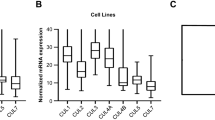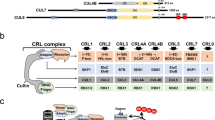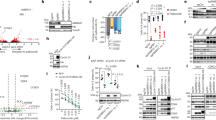Abstract
Cullins are a family of evolutionarily conserved proteins that bind to the small RING finger protein, ROC1, to constitute potentially a large number of distinct E3 ubiquitin ligases. CUL7 mediates an essential function for mouse embryo development and has been linked with cell transformation by its physical association with the SV40 large T antigen. We report here that, like its closely related homolog PARC, CUL7 is localized predominantly in the cytoplasm and binds directly to p53. In contrast to PARC, however, CUL7, even when overexpressed, did not sequester p53 in the cytoplasm. We have identified a sequence in the N-terminal region of CUL7 that is highly conserved in PARC and a sequence spanning the tetramerization domain in p53 that are required for CUL7–p53 binding. CUL7 and MDM2 did not form a detectable tertiary complex with p53. In vitro, CUL7 caused only mono- or di-ubiquitination of p53 under the conditions MDM2 polyubiquitinated p53. Co-expression of CUL7 reduced the transactivating activity of p53. Constitutive ectopic expression of CUL7 increased the rate of cell proliferation and delayed UV-induced G2 accumulation in U2OS cells expressing functional p53, but had no detectable effect in p53-deficient H1299 cells. Deletion of the N-terminal domain of CUL7 or a mutation disrupting p53 binding abolished the ability of CUL7 to increase the rate of U2OS cell proliferation. Our results suggest that CUL7 functions to promote cell growth through, in part, antagonizing the function of p53.
This is a preview of subscription content, access via your institution
Access options
Subscribe to this journal
Receive 50 print issues and online access
$259.00 per year
only $5.18 per issue
Buy this article
- Purchase on Springer Link
- Instant access to full article PDF
Prices may be subject to local taxes which are calculated during checkout








Similar content being viewed by others
References
Ali SH, DeCaprio JA . (2001). Cellular transformation by SV40 large T antigen: interaction with host proteins. Semin Cancer Biol 11: 15–23.
Ali SH, Kasper JS, Arai T, DeCaprio JA . (2004). Cul7/p185/p193 binding to simian virus 40 large T antigen has a role in cellular transformation. J Virol 78: 2749–2757.
Arai T, Kasper JS, Skaar JR, Ali SH, Takahashi C, DeCaprio JA . (2003). Targeted disruption of p185/Cul7 gene results in abnormal vascular morphogenesis. Proc Natl Acad Sci USA 100: 9855–9860.
Bai C, Sen P, Hofmann K, Ma L, Goebl M, Harper JW et al. (1996). SKP1 connects cell cycle regulators to the ubiquitin proteolysis machinery through a novel motif, the F-box. Cell 86: 263–274.
Baptiste N, Prives C . (2004). p53 in the cytoplasm: a question of overkill? Cell 116: 487–489.
Chipuk JE, Green DR . (2004). Cytoplasmic p53: Bax and Forward. Cell Cycle 3: 429–431.
Deshaies RJ . (1999). SCF and cullin/RING H2-based ubiquitin ligases. Annu Rev Cell Dev Biol 15: 435–467.
Dias DC, Dolios G, Wang R, Pan ZQ . (2002). CUL7: a DOC domain-containing cullin selectively binds Skp1.Fbx29 to form an SCF-like complex. Proc Natl Acad Sci USA 99: 16601–16606.
El-Deiry WS, Kern SE, Pietenpol JA, Kinzler KW, Vogelstein B . (1992). Definition of a consensus binding site for p53. Nat Genet 1: 45–49.
Feldman RMR, Correll CC, Kaplan KB, Deshaies RJ . (1997). A complex of Cdc4p, Skp1p, and Cdc53p/Cullin catalyzes ubiquitination of the phosphorylated CDK inhibitor Sic1p. Cell 91: 221–230.
Freemont PS, Hanson IM, Trowsdale J . (1991). A novel cysteine-rich sequence motif. Cell 64: 483–484.
Furukawa M, He YJ, Borchers C, Xiong Y . (2003). Targeting of protein ubiquitination by BTB-Cullin 3-Roc1 ubiquitin ligases. Nat Cell Biol 5: 1001–11007.
Furukawa M, Ohta T, Xiong Y . (2002). Activation of UBC5 ubiquitin-conjugating enzyme by the RING finger of ROC1 and assembly of active ubiquitin ligases by all cullins. J Biol Chem 277: 15758–15765.
Furukawa M, Yanping Z, McCarville J, Ohta T, Xiong Y . (2000). The C-terminal sequence and ROC1 are required for efficient nuclear accumulation, NEDD8 modification, and ubiquitin ligase activity of CUL1. Mol Cell Biol 20: 8185–8197.
Geyer R, Wee S, Anderson S, Yates J, Wolf DA . (2003). BTB/POZ domain proteins are putative substrate adaptors for cullin 3 ubiquitin ligases. Mol Cell 12: 783–790.
Hershko A, Ciechanover A . (1998). The ubiquitin system. Annu Rev Biochem 67: 425–479.
Huibregtse JM, Scheffner M, Beaudenon S, Howley PM . (1995). A family of proteins structurally and functionally related to the E6-AP ubiquitin-protein ligase. Proc Natl Acad Sci USA 92: 2563–2567.
Jenkins CW, Xiong Y . (1995). Immunoprecipitation and immunoblotting in cell cycle studies. In Pagano M (ed.). Cell Cycle: Material and Methods. Springer-Verlag: New York, pp 250–263.
Joazeiro CA, Weissman AM . (2000). RING finger proteins: mediators of ubiquitin ligase activity. Cell 102: 549–552.
Kipreos ET, Lander LE, Wing JP, He W-W, Hedgecock EM . (1996). cul-1 is required for cell cycle exit in C. elegans and identifies a novel gene family. Cell 85: 829–839.
Ko LJ, Prives C . (1996). p53: puzzle and paradigm. Genes Dev 10: 1054–1072.
Levine AJ . (1997). p53, the cellular gatekeeper for growth and division. Cell 88: 323–331.
Lin J, Chen J, Levine AJ . (1994). Several hydrophobic amino acids in the p53 amino-terminal domain are required for transcriptional activation, binding to MDM-2 and the adenovirus 5 E1B 55-kD protein. Genes Dev 8: 1235–1246.
Manke IA, Nguyen A, Lim D, Stewart MQ, Elia AE, Yaffe MB . (2005). MAPKAP kinase-2 is a cell cycle checkpoint kinase that regulates the G2/M transition and S phase progression in response to UV irradiation. Mol Cell 17: 37–48.
Marin I, Lucas JI, Gradilla AC, Ferrus A . (2004). Parkin and relatives: the RBR family of ubiquitin ligases. Physiol Genomics 17: 253–263.
Nikolaev AY, Li M, Puskas N, Qin J, Gu W . (2003). Parc: a cytoplasmic anchor for p53. Cell 112: 29–40.
Ohta T, Michel JJ, Schottelius AJ, Xiong Y . (1999). ROC1, a homolog of APC11, represents a family of cullin partners with an associated ubiquitin ligase activity. Mol Cell 3: 535–541.
O'Keefe K, Li H, Zhang Y . (2003). Nucleocytoplasmic shuttling of p53 is essential for MDM2-mediated cytoplasmic degradation but not ubiquitination. Mol Cell Biol 23: 6396–6405.
Pickart CM . (2001). Mechanisms underlying ubiquitination. Ann Rev Biochem 70: 503–533.
Pintard L, Willis JH, Willems A, Johnson JL, Srayko M, Kurz T et al. (2003). The BTB protein MEL-26 is a substrate-specific adaptor of the CUL-3 ubiquitin-ligase. Nature 425: 311–316.
Roth J, Dobbelstein M, Freedman DA, Shenk T, Levine AJ . (1998). Nucleo-cytoplasmic shuttling of the hdm2 oncoprotein regulates the levels of the p53 protein via a pathway used by the human immunodeficiency virus rev protein. EMBO J 17: 554–564.
Scheffner M, Nuber U, Huibregtse JM . (1995). Protein ubiquitination involving an E1–E2–E3 enzymes ubiquitin thioester cascade. Nature 373: 81–83.
Skowyra D, Craig K, Tyers M, Elledge SJ, Harper JW . (1997). F-box proteins are receptors that recruit phosphorylated substrates to the SCF ubiquitin-ligase complex. Cell 91: 209–219.
Tan P, Fuches SY, Angus A, Wu K, Gomez C, Ronai Z et al. (1999). Recruitment of a ROC1-CUL1 ubiquitin ligase by Skp1 and HOS to catalyze the ubiquitination of IkBa. Mol Cell 3: 527–533.
Tang Z, Li B, Bharadwaj R, Zhu H, Ozkan E, Hakala K et al. (2001). aAPC2 Cullin protein and APC11 RING protein comprise the minimal ubiquitin ligase module of the anaphase-promoting complex. Mol Biol Cell 12: 3839–3851.
Tao W, Levine AJ . (1999). Nucleocytoplasmic shuttling of oncoprotein Hdm2 is required for Hdm2-mediated degradation of p53. Proc Natl Acad Sci USA 96: 3077–3080.
Tsai SC, Pasumarthi KB, Pajak L, Franklin M, Patton B, Wang H et al. (2000). Simian virus 40 large T antigen binds a novel Bcl-2 homology domain 3-containing proapoptosis protein in the cytoplasm. J Biol Chem 275: 3239–3246.
Xu L, Wei Y, Reboul J, Vaglio P, Shin TH, Vidal M et al. (2003). BTB proteins are substrate-specific adaptors in an SCF-like modular ubiquitin ligase containing CUL-3. Nature 425: 316–321.
Yu H, Peters J-M, King RW, Page AM, Hieter P, Kirschner MW . (1998). Identification of a cullin homology region in a subunit of the anaphase-promoting complex. Science 279: 1219–1222.
Zachariae W, Shevchenko A, Andrews PD, Ciosk R, Galova M, Stark MJR et al. (1998). Mass spectrometric analysis of the anaphase-promoting complex from yeast: identification of a subunit related to cullins. Science 279: 1216–1219.
Zhang Y, Xiong Y . (2001a). Control of p53 ubiquitination and nuclear export by MDM2 and ARF. Cell Growth Diff 12: 175–186.
Zhang Y, Xiong Y . (2001b). A p53 amino-terminal nuclear export signal inhibited by DNA damage- induced phosphorylation. Science 292: 1910–1915.
Zhang Y, Xiong Y, Yarbrough WG . (1998). ARF promotes MDM2 degradation and stabilizes p53: ARF-INK4a locus deletion impairs both the Rb and p53 tumor suppression pathways. Cell 92: 725–734.
Acknowledgements
We thank Gabrielle White Wolf for providing insightful discussion throughout this study, Toru Nishikawa for helping perform p53 ubiquitination assays and other members of Xiong lab for discussions. This study was supported by NIH grant CA65572 (YX).
Author information
Authors and Affiliations
Corresponding author
Rights and permissions
About this article
Cite this article
Andrews, P., He, Y. & Xiong, Y. Cytoplasmic localized ubiquitin ligase cullin 7 binds to p53 and promotes cell growth by antagonizing p53 function. Oncogene 25, 4534–4548 (2006). https://doi.org/10.1038/sj.onc.1209490
Received:
Revised:
Accepted:
Published:
Issue Date:
DOI: https://doi.org/10.1038/sj.onc.1209490
Keywords
This article is cited by
-
The functional analysis of Cullin 7 E3 ubiquitin ligases in cancer
Oncogenesis (2020)
-
Cytoplasmic E3 ubiquitin ligase CUL9 controls cell proliferation, senescence, apoptosis and genome integrity through p53
Oncogene (2017)
-
A large-scale mutation search reveals genetic heterogeneity in 3M syndrome
European Journal of Human Genetics (2009)
-
Gene expression variation to predict 10-year survival in lymph-node-negative breast cancer
BMC Cancer (2008)
-
A complex barcode underlies the heterogeneous response of p53 to stress
Nature Reviews Molecular Cell Biology (2008)



